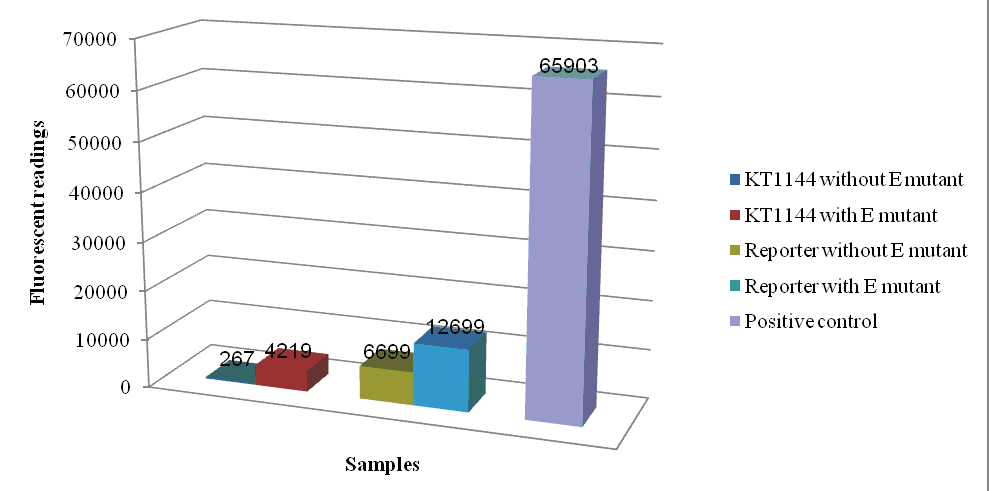Team:Calgary/Lab/Mutant
From 2009.igem.org
(Difference between revisions)
| Line 83: | Line 83: | ||
The circuits are almost identical in that they have the same promoter (BBa_R0040), RBS (BBa_B034) and terminator (BBa_B0015). This design will allow for constitutive expression of these proteins. The LuxO D47A mutant mimics the unphosphorylated and thus inactive form of LuxO, meaning that it will not bind to the qrr4 promoter. The LuxO D47E mutant, however, mimics the phosphorylated and thus active form of LuxO, and will thus bind to the qrr4 promoter and induce expression of downstream genes. Once these circuits are tested with a non-Biobrick reporter (in the KT1144 cells) they are used to test whether the reporter circuit is functional. If in the presence of the LuxO D47A mutant the reporter cells do not glow and if in the presence of the LuxO D47E mutant the reporter cells do glow, we know the reporter circuit is functional. | The circuits are almost identical in that they have the same promoter (BBa_R0040), RBS (BBa_B034) and terminator (BBa_B0015). This design will allow for constitutive expression of these proteins. The LuxO D47A mutant mimics the unphosphorylated and thus inactive form of LuxO, meaning that it will not bind to the qrr4 promoter. The LuxO D47E mutant, however, mimics the phosphorylated and thus active form of LuxO, and will thus bind to the qrr4 promoter and induce expression of downstream genes. Once these circuits are tested with a non-Biobrick reporter (in the KT1144 cells) they are used to test whether the reporter circuit is functional. If in the presence of the LuxO D47A mutant the reporter cells do not glow and if in the presence of the LuxO D47E mutant the reporter cells do glow, we know the reporter circuit is functional. | ||
<br><br> | <br><br> | ||
| - | + | <b>CHARACTERIZATION<b> | |
<br> | <br> | ||
| + | In order to use the mutant circuits to test whether the reporter circuit is functional, we must first verify that the mutant circuits themselves are functional. This was done by transforming each mutant circuit separately into KT1144 cells that have the qrr4 promoter followed by GFP on a cosmid (this was provided by Bonnie Bassler - see acknowledgments). The expectation was such that without LuxO D47E, the KT1144 cells would have basal levels of fluorescence, but upon the addition of the mutant, fluorescence would increase. This is because LuxO D47E mimics the phosphorylated and thus active form of LuxO and should bind to the qrr4 promoter and induce expression of GFP. Below depicts the results of the fluorescent readings and the protocol can be found under the figure. | ||
<br> | <br> | ||
| - | |||
<br> | <br> | ||
| + | </html> | ||
| + | [[Image:calgary_reporter_testing.png|700px]] | ||
| + | <html> | ||
| + | <b>Figure 2. Fluorescent readings when testing LuxO D47E mutants in KT1144 cells and testing the reporter circuit with functional LuxO D47E mutants.</b> This graph is divided into two lines of cells and a positive control. The left hand bars depict the KT1144 cells with and without LuxO D47E. This graph shows that without the LuxO D47E mutant in the KT1144 cells, fluorescence reads at 267, whereas with the mutant, fluorescence reads at 4219. This increase in fluorescence shows that the LuxO D47E mutant is functional. These mutants can now be used to test the reporter circuit, which is shown in the next line of cells that shows reporter circuit with and without LuxO D47E in order to determine whether the reporter circuit is functional. Fluorescences levels increase upon the addition of the LuxO D47E mutant and therefore the reporter circuit is functional. See 'reporter circuit' on the side bar for more information on testing the reporter. The positive control is the TetR promoter followd by an RBS and GFP. TOP10 cells with pBluescript were used as a negative control and to blank the plate reader | ||
<br> | <br> | ||
| - | |||
<br> | <br> | ||
| - | + | <b>Protocol for fluorescent readings</b> | |
| + | <br> | ||
<br>1. Grow overnight cultures of each sample | <br>1. Grow overnight cultures of each sample | ||
<br>2. Power on the Bio-tec Synergy HT plate reader, or another plate reader, and KC4 application. | <br>2. Power on the Bio-tec Synergy HT plate reader, or another plate reader, and KC4 application. | ||
Revision as of 16:57, 21 October 2009
UNIVERSITY OF CALGARY

 "
"











 The purpose of the mutant circuits is to test that the reporter circuit is functional so it can be used to test the functionality of the signalling circuit.
The purpose of the mutant circuits is to test that the reporter circuit is functional so it can be used to test the functionality of the signalling circuit.


